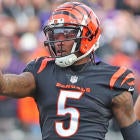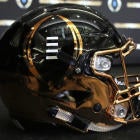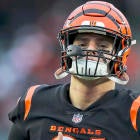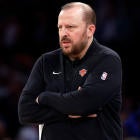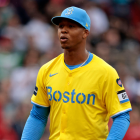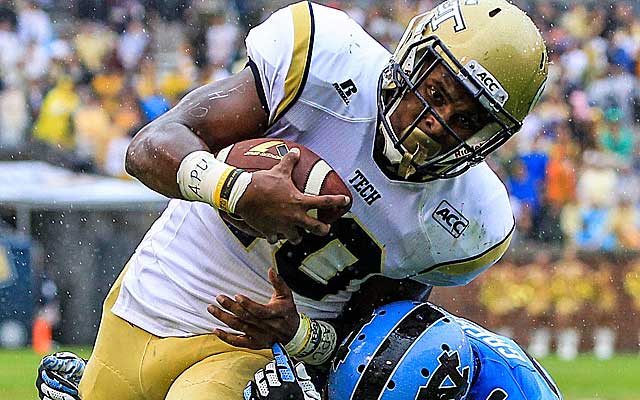
The concept seemed to surprise Ramogi Huma.
"There has been zero talk of a boycott," said the president of the National College Players Association, whose organization may have made the biggest news of the college football weekend.
The possibility of an outward protest had been brought up within the NCPA players' council who masterminded Saturday's All Players United campaign. The acronym APU trumped SEC, ACC, NCAA or ESPN over the weekend. Twenty-eight players nationwide chose to adorn their equipment in some way with the initials bringing awareness to players' rights. Just 28. Seems insignificant, the benign awareness expressed by players who have awakened to their rights.
But Huma and the players got the desired effect. All Players United became a national story covered by national outlets. Northwestern quarterback Kain Colter added credibility as one of the leaders of the NCPA players' council who helped develop APU. There is a Twitter movement -- #APU, #AllPlayersUnited.
If players from Georgia, Georgia Tech and a Northwestern quarterback are involved, who's next? They talked openly and proudly of what they have created. But, Huma stressed, the idea of a full-on protest never moved out of the meeting room.
For the moment.
"What those guys did is going to inspire other guys," said Huma, whose non-profit NCPA is now more than a decade old. "There is an outlet to put pressure on the NCAA to do right for its athletes."
The NCAA reacted saying it is open to "civil debate," because what other choice does it have? The association has created that civil debate and is no longer in charge of it. It can be argued that the governing body is now in self-preservation mode. Major lawsuits loom. Folks are questioning the existence of the association itself.
When the commissioners spoke out adamantly in July, Mark Emmert embraced the discourse. Save-the-date notices were sent to administrators for a discussion at January's NCAA Convention. A survey was sent out asking participants how they want the board of directors to look in the future.
That missed the point. Who says there is going to be an NCAA board of directors in the future? It's gotten to that point. With criticism and lawsuits swirling, the fact that the players themselves -- the labor force -- are protesting changes the discussion.
Huma and the players themselves probably don't even know it fully, but they now have the leverage in this battle. They have read "The Shame of College Sports." The money has become obscene. Commissioners make $1 million per year. Coaches make five times that amount.
Conference realignment ripped traditions asunder. Arian Foster says he took money at Tennessee. Then he was called a "prostitute" by a cartoon caricature of a basketball analyst whose sport is as much in the gutter as any.
The Johnny Manziel and Oklahoma State reports are making folks pick a side on the issue of compensating players. Tattoogate at Ohio State just doesn't seem like that big a deal anymore.
Meanwhile, the profits of the sport are built on the labor of those players. They control the outcome of this debate. They are the product. The players are just now realizing their leverage. It is similar to the commissioners who have them playing at 9 p.m. ET, getting back to campus at 4 a.m. and traveling 1,000 miles to play a conference game.
The commissioners want more autonomy, more power in deciding how a system they largely created and rule runs on a daily basis. If not, there exists a vague threat those BCS commissioners could break away from the NCAA.
They have ignored, or underestimated, the players' new-found power. Like any organized union, the players can withhold their services. We're not talking a fist-in-the-air, power-to-the-people, walk-off-the-field moment. Not yet. Just imagine players deciding to delay the start of a game by 10 minutes as a symbolic protest. That could conceivably destroy a network's precious broadcast "window". And that might be enough.
It's not a new idea. It's the same power at least two prominent basketball programs had in the late 1980s, early 1990s. That's as specific as Sonny Vaccaro will get. The former Nike marketing executive and current consultant in the Ed O'Bannon vs. NCAA case told CBSSports.com, "Two specific teams had talked about something like that, one team was pretty far down to the line. ... A player or players would have delayed a major, major game that the world was hooked to. Then everybody would have panicked. ... They had the power in their hands."
It's no secret back then Vaccaro was closely affiliated with Michigan, UNLV and Georgetown. It's also obvious he was talking about a Final Four.
The issue then, as now, was player rights. Back in the day, it was Chris Webber's parents not being able to afford to buy their son's jersey. Scholarships can still be pulled at the whim of a coach (four-year scholarships are now an option for schools). Players are more aware of concussions and head trauma and the vegetables they could become decades from now after playing college football.
The NCPA players' council wants to reduce full-contact practices for what amount to athlete-students. They want independent concussion experts on the sidelines. They want part of those college football playoff revenues used for research into head trauma.
It doesn't seem like too much to ask. The Pac-12 has been somewhat of an ally, limiting full contact practices to two days a week. Huma has reached out to the other BCS commissioners but has not gotten much of a response.
The two sides essentially agree on the stipend issue. The NCAA settled a lawsuit to pay $218 million into the NCAA Student-Athlete Opportunity Fund. BCS commissioners are talking openly about the full cost of attendance.
Questions surround semantics and funding. There are huge Title IX issues to be worked out. The last woman on the equestrian team should get access to the same funds as the Heisman-winning quarterback. Meanwhile, the NCAA and schools don't want it to seem like they are "paying" players.
Be aware: The actual money to compensate athletes probably isn't going to come out of the bottom line. Get ready, then, for higher ticket prices, student fees and souvenir costs. The issue remains complicated.
It was that O'Bannon lawsuit that galvanized some level of public, legal and player sentiment against the likeness rights retained by the NCAA. A few active players have joined the class action legal challenge against the NCAA.
"It started back when the players joining O'Bannon started to catch criticism on social media," Huma said. "Some of the players on our players' council wanted to show support. That's when they started brainstorming."
What's amazing is the NCPA players kept Saturday's rollout of APU a secret for months. This is not to say the movement is going to spread like the Andromeda Strain, but it does have the foundation of 1960s social awareness.
"These kids are now public figures because the numbers are so big," Vaccaro said. "Do I think something [like a protest] is going to happen eventually? Yes, because they're organized now."
And the last thing the NCAA wants is organized players. That hints of a union. If that happens, that's when the NCAA disintegrates. It can't exist being responsible for workers' compensation or negotiating union contracts. In fact, the NCAA may owe its existence to a 1950s court decision that it wasn't liable for workers' comp.
Vaccaro, "the godfather of grassroots basketball," should know the APU/NCPA has the same grassroots feel. It's easy to dismiss a non-profit operated out of Riverside, Calif., with annual budget of $200,000. But the fight has the same feel as Boise State over Oklahoma. Everyone loves an underdog.
"They're getting their own courage and people are having their backs," Vaccaro said of the APU players.
The same reason the commissioners are asking for reform is the same reason the players could boycott for it. Both have that leverage. Huma reiterated that such an outward display of protest is not an option at the moment. Those players would risk a rebuke from their coaches, administrations and the NCAA. A segment of the population believe a free scholarship worth $40,000 or more per year -- before financial aid -- is enough.
But let's not forget who controls the product.
"They've created something other players can gravitate toward," Huma said. "They didn't try to force everybody to do it."
One thing you can expect is that this movement will be spread. It has to. The views are too divergent now. The opposing parties are on opposite ends of a national debate.
Who knows where it will lead?
"You're not going to likely see players marching," Huma said. "This form of demonstrating can still be as powerful."
For the moment.













